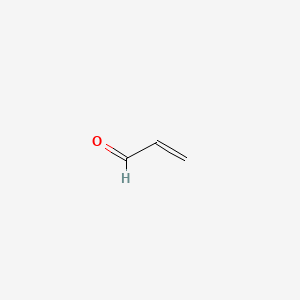Ferroptosis-centered Drug Response Information
General Information of the Drug (ID: ferrodrug0005)
| Name |
Acrolein
|
||||
|---|---|---|---|---|---|
| Synonyms |
ACROLEIN; Acrylaldehyde; 2-Propenal; 107-02-8; Propenal; Acrylic aldehyde; prop-2-enal; Allyl aldehyde; Ethylene aldehyde; Aqualin; Magnacide H; Acraldehyde; Slimicide; 2-Propen-1-one; Aqualine; Crolean; Prop-2-en-1-al; Magnacide; Acquinite; Biocide; Acrylaldehyd; Acroleina; Acroleine; Akrolein; Akroleina; Papite; Aldeide acrilica; Aldehyde acrylique; Acraldehydeacroleina; NSC 8819; Rcra waste number P003; Propenaldehyde; trans-Acrolein; Caswell No. 009; Magnacide B; Aldehyde, Allyl; Aldehyde, Acrylic; Aldehyde, Ethylene; Magnacide H and B; CCRIS 3278; HSDB 177; UN 1092; CHEBI:15368; 2-Propenaldehyde; EINECS 203-453-4; UNII-7864XYD3JJ; EPA Pesticide Chemical Code 000701; Acrolein (stabilized with hydroquinone); 7864XYD3JJ; DTXSID5020023; AI3-24160; CH2=CHCHO; NSC-8819; 25068-14-8; CHEMBL721; DTXCID8023; EC 203-453-4; ACROLEIN (IARC); ACROLEIN [IARC]; ACROLEIN (MART.); ACROLEIN [MART.]; Akrolein [Czech]; Propenal [Czech]; Acrolein, analytical standard; Akroleina [Polish]; Acroleina [Italian]; Acrylaldehyd [German]; 2 Propenal; Acroleine [Dutch, French]; Aldeide acrilica [Italian]; Propadien-1-ol; Aldehyde acrylique [French]; Acrolein, inhibited; Propenal, inhibited; Acraldehydeacroleina [Italian]; UN1092; RCRA waste no. P003; Acrylic aldehyde, inhibited; allol; Acrylehyde; Allylaldehyde; Acrehyde; Acrylehyd; Aerolein; Acrolein Monomer; 2-propen-1-al; prop-2-en-1-one; 81788-96-7; ACROLEIN [HSDB]; ACROLEIN [INCI]; ACROLEIN [MI]; Epitope ID:143621; WLN: VH1U1; Acroleine(DUTCH, FRENCH); trans-Acrolein Formylethylene; GTPL2418; DTXSID50526220; NSC8819; Acrolein 5000 microg/mL in Water; BCP07056; STR00291; Acrolein 100 microg/mL in Acetone; Tox21_200984; BDBM50010912; Acrolein 1000 microg/mL in Methanol; Acrolein 5000 microg/mL in Methanol; AKOS000120766; Acrolein, 96%, stab with hydroquinone; NCGC00091484-01; NCGC00091484-02; NCGC00258537-01; BP-14004; CAS-107-02-8; Acrolein, inhibited [UN1092] [Poison]; A0137; C01471; InChI=1/C3H4O/c1-2-3-4/h2-3H,1H; A801558; Q342790; Acrolein 5000 microg/mL in Methanol, Second Source; Acrolein, contains hydroquinone as stabilizer, 90%; Acrolein, stabilized with 3 wt% water, 1000ppm hydroquinone, stored over Copper
Click to Show/Hide
|
||||
| Status |
Investigative
|
||||
| Drug Type |
Small molecular drug
|
||||
| Structure |
 |
||||
| Formula |
C3H4O
|
||||
| IUPAC Name |
prop-2-enal
|
||||
| Canonical SMILES |
C=CC=O
|
||||
| InChI |
InChI=1S/C3H4O/c1-2-3-4/h2-3H,1H2
|
||||
| InChIKey |
HGINCPLSRVDWNT-UHFFFAOYSA-N
|
||||
| PubChem CID | |||||
| TTD Drug ID | |||||
Full List of Ferroptosis Target Related to This Drug
Unspecific Target
| In total 2 item(s) under this Target | ||||
| Experiment 1 Reporting the Ferroptosis-centered Drug Act on This Target | [1] | |||
| Responsed Disease | Diabetes mellitus | ICD-11: 5A10 | ||
| Responsed Regulator | Peroxisome proliferator-activated receptor gamma (PPARG) | Suppressor | ||
| Pathway Response | Fatty acid metabolism | hsa01212 | ||
| Ferroptosis | hsa04216 | |||
| Glutathione metabolism | hsa00480 | |||
| Cell Process | Cell ferroptosis | |||
| Cell proliferation | ||||
| In Vitro Model | MIN6 cells | Insulinoma | Mus musculus | CVCL_0431 |
| Response regulation | Acrolein is a typical food and environmental pollutant and a risk factor for diabetes. Resveratrol, an antioxidant natural product, may relieve ER stress and upregulate PPAR expression, thereby inhibiting acrolein-induced ferroptosis. | |||
| Experiment 2 Reporting the Ferroptosis-centered Drug Act on This Target | [3] | |||
| Responsed Disease | Health | ICD-11: N.A. | ||
| Pathway Response | Fatty acid metabolism | hsa01212 | ||
| Cell Process | Cell ferroptosis | |||
| In Vitro Model | Arabidopsis thalianasuspension cells (Arabidopsis thalianasuspension cells) | |||
| Response regulation | Acrolein, a lipid peroxide-derived reactive carbonyl species, is involved in plant ferroptosis-like cell death. The acrolein induced cell death could be mitigated by the known ferroptosis inhibitors such as Ferrostatin-1, Deferoxamine, a-Tocopherol, and glutathione. | |||
Prostaglandin G/H synthase 2 (PTGS2)
| In total 1 item(s) under this Target | |||||
| Experiment 1 Reporting the Ferroptosis-centered Drug Act on This Target | [2] | ||||
| Target for Ferroptosis | Marker | ||||
| Responsed Disease | Aortic aneurysm | ICD-11: BD50 | |||
| Pathway Response | Fatty acid metabolism | hsa01212 | |||
| Ferroptosis | hsa04216 | ||||
| Cell Process | Cell ferroptosis | ||||
| In Vitro Model | rVSMCs (Rat vascular smooth muscle cells) | ||||
| A7r5 cells | Normal | Rattus norvegicus | CVCL_0137 | ||
| EAhy926 cells | Normal | Homo sapiens | CVCL_3901 | ||
| C3H/10T1/2 cells | Normal | Mus musculus | CVCL_0190 | ||
| In Vivo Model |
C57BL/6J wild-type mice (8-10 wk old, male) were purchased from Japan SLC (Tokyo, Japan). Mice were housed (4/cage, RAIR HD-ventilated micro-isolator animal housing systems; Laboratory Products, Seaford, DE) in an environment maintained at 23 ± 2 with ad libitum access to food and water under a 12-h:12-h light-dark cycle, with lights on from 0800 to 2000. A total of 13 mice were used. The aorta was harvested immediately after mice were euthanized by inhalation of carbon dioxide, washed in 0.1% antibiotics/PBS, and cut into 3-4-mm rings. The aortic rings were cultured in 10% FCS/DMEM for 3 h and then treated with CSE (0.8 mg/mL) for the indicated periods.
Click to Show/Hide
|
||||
| Response regulation | VSMC ferroptosis was induced by acrolein and methyl vinyl ketone, major constituents of CSE. CSE also induced the upregulation of Ptgs2 mRNA, lipid peroxidation, and intracellular GSH depletion, which are key features of ferroptosis. These findings suggest that ferroptosis is a potential therapeutic target for preventing aortic aneurysm and dissection. | ||||
References
